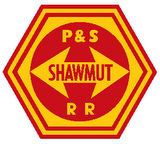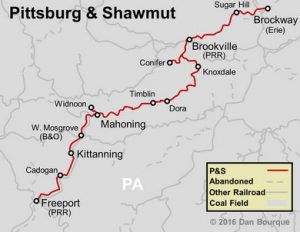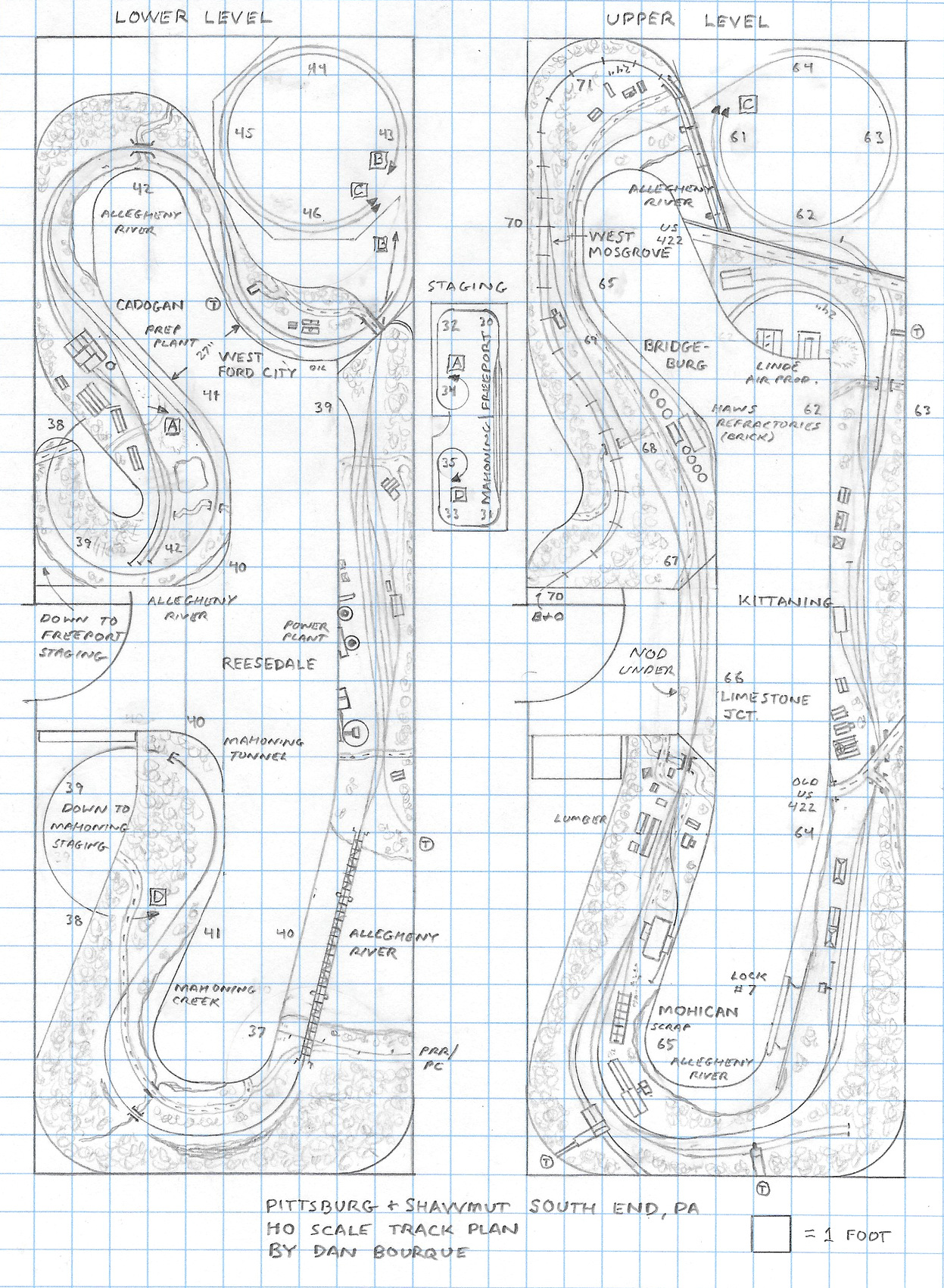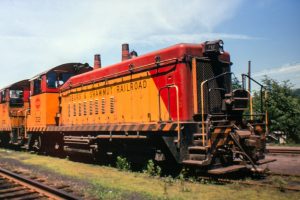- Size: 10′ x 30′
- Scale: HO
- Minimum Radius: 27″ mainline (24″ on some spurs and the B&O)
- Minimum Aisle Width: 27″
- Designed by Dan Bourque
 The south end of the Pittsburg & Shawmut Railroad occupied the west bank of the Allegheny River valley for its last 24 miles from Reesedale to Freeport, Pennsylvania. Along the narrow right-of-way were tipples, numerous industries, interchanges with the B&O and PRR, and the P&S headquarters at Kittaning. Unlike the northern section of the railroad which was marked by tunnels and tall trestles, most of the southern end was water-level with little grade. The greatest scenic feature on the southern end was the 1,124 foot long truss bridge across the Allegheny River where the P&S left the river valley to follow Mahoning Creek to the north. The mix of industries, close towns, and tight spaces along the river make this a great area to model.
The south end of the Pittsburg & Shawmut Railroad occupied the west bank of the Allegheny River valley for its last 24 miles from Reesedale to Freeport, Pennsylvania. Along the narrow right-of-way were tipples, numerous industries, interchanges with the B&O and PRR, and the P&S headquarters at Kittaning. Unlike the northern section of the railroad which was marked by tunnels and tall trestles, most of the southern end was water-level with little grade. The greatest scenic feature on the southern end was the 1,124 foot long truss bridge across the Allegheny River where the P&S left the river valley to follow Mahoning Creek to the north. The mix of industries, close towns, and tight spaces along the river make this a great area to model.
The Layout
 This track plan captures the key scenes of the P&S in the Allegheny River valley from Reesedale to Cadogan, PA circa the late ’60s and early ’70s. Because the P&S stayed on the same side of the river through this section, the challenge was keeping a “right is north” orientation throughout–this is easy for a single-deck plan, but most double-deck plans reverse directions between decks. To aid in the design, I went with something I usually avoid, a duck-under. In this case, it’s a nod-under of tracks that are 66″ off the ground, so it wouldn’t be too much of a pain. Because of the narrow space, the basic footprint was pretty much set, so then I just had to pick what scenes went where.
This track plan captures the key scenes of the P&S in the Allegheny River valley from Reesedale to Cadogan, PA circa the late ’60s and early ’70s. Because the P&S stayed on the same side of the river through this section, the challenge was keeping a “right is north” orientation throughout–this is easy for a single-deck plan, but most double-deck plans reverse directions between decks. To aid in the design, I went with something I usually avoid, a duck-under. In this case, it’s a nod-under of tracks that are 66″ off the ground, so it wouldn’t be too much of a pain. Because of the narrow space, the basic footprint was pretty much set, so then I just had to pick what scenes went where.
The “must have” for me was the line between Kittaning and Bridgeburg which includes the tiny yard at Kittaning, several industries and a couple of loaders near Mohican, and the short West Mosgrove Branch which connected the P&S and the B&O which was much higher on the same hillside. The “nice to haves” were Cadogan, home of a large coal prep-plant a few miles south of Kittaning, and Reesedale, home of both a coal-burning power plant and the long Allegheny River Bridge a few miles north of Bridgeburg. This lent itself nicely to a down-up-down design with the “must haves” making up the upper deck, the “nice-to-haves” on either end making up the lower deck, and the “few miles” between scenes making up the helix.
Because of the three scenes, there are six places where the track much punch through the backdrop. Thankfully, the P&S provides some great answers including Mahoning Tunnel just north of Reesedale, the B&O deck truss bridge at Bridgeburg, and a few well-placed and prototypical highway overpasses. The south end of Reesedale is the only transition without a ready answer, but a highway overpass or conveyor wouldn’t be out-of-character if the trees didn’t adequately cover the hole in the backdrop. The biggest compromise I had to make was between Kittaning and Mohican. While these towns are close together, there was enough room for the tipple tracks at Mohican and the truck dump just south to tie back into the mainline–I’ve left them stub-ended to save space and to allow the trees to create a little separation between scenes.
Staging would only require a handful of tracks (4-5 would be plenty), so I’ve designed it as a single double-ended yard under Reesedale to represent both the southern terminus at Freeport and the small yard at Mahoning on the north end that was the unofficial dividing line between the Kittaning-based locals and the Brookville-based locals on the north end. This arrangement also turns the entire railroad into a giant continuous running loop. Construction would be pretty simple with the walls supporting most of the benchwork and room in the turn-backs at either end to support the upper deck. The nod-under is also designed to lift-out to aid construction, though the two switches in the section would add complexity and potentially depth to the lift-out depending on what kind of switch manipulation is used. There are some scenes about 4 feet deep, but I was able to keep all the switches within two feet of the aisles to mitigate trouble. A DCC system with walk-around throttles would help simplify wiring and ensure crews could follow their trains.
Operations
On the P&S, it was rare to find two P&S trains in the same place at the same time. While this layout would support multiple trains, it would be prototypical to run them one at a time making this a great layout for 1-2 operators at a leisurely pace. In fact, sessions representing 12 hours would probably work best. On an AM shift, the day might start with a South Rounder led by 2-3 SW9s bringing a train of coal loads in from north staging (Mahoning). The rounders worked in the evening or overnight with the South Rounder originating in Brookville and working south to Kittaning and the North Rounder originating in Kittaning and working north to the end of the line at Brockway before returning halfway to tie up in Brookville and becoming a South Rounder the next day. The South Rounder might work the loaders at Mohican dropping the last of its empties and pulling the loads before dropping the loads in the Kittaning Yard and tying up on the tracks south of the Old US 422 bridge (next to the “G” in “Kittaning” on the plan). Next might come a Kittaning Local #2 from Freeport staging ending its evening run by bringing back interchange traffic and empty hoppers from the PRR at Freeport to Kittaning, perhaps setting out some empties at the couple of tipples along the way before tying up in Kittaning. Next would come the star, the Kittaning Local #1. The locals would start in Kittaning with 2-3 SW9s, and they had a lot of work to do both north and south including 1) working the industries on the south end of the railroad, 2) working the handful of tipples on the south end, 3) working the coal prep plant at Cadogan, 4) working the B&O interchange at West Mosgrove, 5) working the PRR/PC interchange at Freeport, and 6) working the power plant at Reesedale.
Industries included Haws Refractories in Bridgeburg that made bricks for the steel industry; a lumber yard that loaded pressure treated lumber, a mystery industry that took covered hoppers, and a scrap dealer (M. N. Adelson and Sons) in Mohican; the big Linde Air Products Company in Kittaning that shipped industrial gasses in special green-and-white Linde boxcars and big Union Carbide tank cars; and finally a Pennzoil dealer in West Ford City (the dealer was no longer active in the ’60s, but hey. . .). Coal tipples included a small truck dump along the Allegheny River at Reesedale that was active in the ’70s (the lead is represented in the plan, but the tipple could be added), the Mohican tipple (closed in ’65), a busy truck dump at Mohican (’60s and ’70s), smaller truck dumps at Kittaning (Swallow closed in the ’50s, but why not) and just south of West Ford City (’60s), and the large prep plant at Cadogan. Cadogan loaded its own coal until 1969, but it continued operating as a prep plant until 1977 taking raw coal and loading clean coal. Mohican would have cleaned its own coal, but it makes sense for the coal from the truck dumps (to include some brought in from staging by the South Rounder) to go to Cadogan, and it adds extra operational interest. After returning to Kittaning, the local would classify cars in the small yard with some heading to the PRR at Freeport, others to the B&O at West Mosgrave and still others to the Erie Lackwanna at Brockway at the north end of the P&S. The local would haul the B&O traffic a few miles north to Limestone Junction where a short branch climbed a 1.75% (the layout is 3%) grade to reach the interchange track at West Mosgrave–to simplify operations, locomotives would lead heading up the hill and trail coming down back to Kittaning. The last job would be to head north to pull the strings of 55T empties (the dumper couldn’t take 100T cars) from the power plant at Reesedale and take them north into Mahoning staging for loading at Dora (’70s), between Mahoning and Brookville. Depending on the traffic load, the Kittaning Local might also work one or more of the half dozen small loaders between Reesedale and Dora and exchange northbound cars with the Brookville Local, so some additional empties might be taken from Kittaning to join the power plant cars.
For a PM session, things would start with the Kittaning Local #1 returning from north staging with loads. After crossing the Allegheny River, the Local would drop long strings of loaded 55T hoppers in the yard at Reesedale to be worked by the plant’s own switcher, an orange GE 35-tonner labeled “West Penn Power 1”. The local would continue back to Kittaning with any coal loads it picked up working north, perhaps working some industries along the way. During busier times, a Kittaning Local #2 might be called (or you could just keep calling it #1 working an extended shift). On the layout, this crew would do any other switching and jobs necessary on the south end of the railroad including working any of the industries and tipples above. The job might end with the SW9s taking interchange traffic bound for the PRR from Kittaning all the way to Freeport staging–in the ’60s and ’70s, these cars were always shoved with the locomotives trailing. Finally, a North Rounder would be called in Kittaning to take any remaining northbound traffic (including E-L bound cars) to staging. If the Kittaning Locals were particularly, busy, the Rounder might work some tipples along the way.
As you might guess, there is a lot of variety to be had even with the 3-4 trains that plied these rails. While some industries like Linde were served almost every day (Linde also had its own switcher), others might only be served once every few sessions. Tipples were also idled or working full capacity depending on demand. Some sessions might also favor different interchange partners with more cars heading north to the E-L, south to the PRR or on-layout to the B&O. If you didn’t want a lot of switching work to do, you could have a late ’70s or early ’80s session as well where Cadogan and most of the loaders are shut down. During these years, the Kittaning Local worked further north toward Dora where the loaders were still active, so empties and loads would mainly cycle in and out of Mahoning staging.
If this area intrigues you, I highly recommend the book Pittsburg & Shawmut in Color by Kurt Reisweber and Brad Esposito–wonderful photographs and a wealth of information about the trains and operations!
Things I Like About this Plan:
- Great mix of coal and non-coal industries
- Long runs for trains
- Some great scenes (e.g., bridge across the Allegheny River)
- Continuous running option
Things I Don’t Like About this Plan:
- Three helices (at least two are short)
- Duck under (even if it’s high off the ground)
- Lots of compression between scenes on the upper deck
Related Products:






Dan,
I really like your track plans and look forward to the posts. This one is excellent! If I had another 5 feet on my room, it would be very tempting.
in a case of good luck , Doug Lilly just posted some cool P & S photos on RailPictures.net The trestles are incredible.